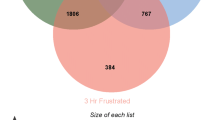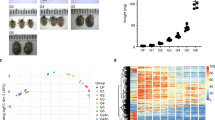Abstract
Towards discovery of molecular signaling cascades that trigger and/or facilitate the tick attachment and formation of its feeding lesion, suppressive subtractive hybridization, high throughput sequencing and validation of differential expression by cDNA dot blot hybridization were performed on Amblyomma americanum ticks that had attained appetence and were exposed to feeding stimuli. This approach allowed for identification of 40 genes that are up regulated before ticks begin to penetrate the host skin. Based on BLAST and secondary structure homology searches as well as motif scan analyses, provisional identification was assigned to ∼38% (15/40) of the identified genes that have been classified into 6 groups: Ligand binding (2 insulin-like growth-factor binding, lipocalin/histamine binding), immune responsive (tumor necrosis receptor associated factor 6, Microplusin-like antimicrobial), stress response proteins (Heat shock protein [HSP] 90, HSP40, 78 kDa glucose regulated protein [GRP78]), transporter polypeptides (ABC transporter and organic anion transporter polypeptide [contains Kazal-type serine proteinase inhibitor domain]) and enzymes/regulators (extracellular matrix mettaloprotease inducer, chitinase), extracellular matrix-like proteins (tropoelastin, flagelliform silk protein). Sixty-two percent (25/40) of genes that did not show similarity to known proteins are classified as orphans. BLASTN homology search against the tick EST database revealed that 50% (20/40) of candidate genes are conserved in other ticks suggesting that molecular events underlying the A. americanum tick attachment phase may be conserved in other tick species. Consistent with the general assumption that genes that are up regulated in ticks before they started to penetrate host skin represented the tick’s molecular preparedness to evade host defense during the attachment phase, real time RT-PCR analyses data demonstrated that the majority of the tested genes (9/11) were highly expressed during the first 24 h of feeding. Identification of genes in this study provides the framework for future studies to elucidate molecular signaling cascades that regulate early molecular events during the tick attachment phase.





Similar content being viewed by others
References
Anderson RB, Scrimgeour GJ And Reuben K (1998) Responses of the ixodid tick, Amblyomma hebraeum (Acari: Ixodidae), to carbon dioxide. Exp Appl Acarol 22:667–681
Bach LA, Headey SJ, Norton RS (2005) IGF-binding proteins-the pieces are falling into the place. Trend Endocrinol Metab 15:228–234
Blakytny R, Jude EB, Gibson MJ, Boulton AJM, Fergusson MW (2000) Lack of insulin-like growth factor 1 (IGF1) in the basal keratinocyte layer of diabetic skin and diabetic foot ulcers. J Pathol 190:589–594
Brossard M, Wikel SK (2004) Tick immunology. Parasitology 129:S161–S171
Burgdorfer W (1991) Lyme borreliosis: ten years after discovery of the etiologic agent, Borrelia burgdorferi. Infection 19:257–262
Childs JE, Paddock CD (2002) The ascendancy of Amblyomma americanum as a vector of pathogens affecting humans in the United States. Annu Rev Entomol 48: 307–337
Davey RB (1987) Effect of age of Boophilus microplus larvae (Aacri: Ixodidae) on attachment to cattle. J Med Entomol 24:118–120
Davis HH, Dotson EM, Oliver JH Jr (1994) Localization of insulin-like immunoreactivity in the synganglion of nymphal and adult Dermacentor variabilis (Acari: Ixodidae). Exp Appl Acarol 18:111–122
Dielgelmann RF, Evans MC (2004) Wound healing: an overview of acute, fibrotic and delayed healing. Front Sci 9:283–289
Duan C, Xu Q (2005) Roles of insulin-like growth factor (IGF) binding proteins in regulating IGF actions. Gen Comp Endocrinol 142:44–52
Dunaiski V, Belford DA (2002) Contribution of circulating IGF-1 to wound repair in GH treated rats. Growth Horm IGF Res 12:381–387
Edmonson SR, Thumiger SP, Whether GA And Wraight CJ (2003) Epidermal homeostasis: The role of the growth hormone and insulin-like growth factor systems. Endocr Rev 24:737–764
Gabison EE, Hoang-Xuan T, Mauviel A, Menashi S (2005) EMMPRIN/CD147, an MMP modulator in cancer development and tissue repair. Biochimie 87:361–368
Gladney WJ, Drummond RO, Whetstone TM, Ernst SE (1970) Effect of age on the attachment rate the parasitic stage of the Lone Star tick, Amblyomma americanum (Linnaeus) (Aacrina: Ixodidae), in the laboratory. J Med Entomol 7:92–95
Gratz NG (1999) Emerging and resurging vector-borne diseases. Ann Rev Entomol 44:51–75
Hill CA, Wikel SK, (2005) The Ixodes scapularis genome project: an opportunity for advancing tick research. Trends Parasitol 21:151–153
Holly J, Perks C (2006) The role of insulin-like growth binding proteins. Neuroendocrinology 83:154–160
Hwa V, Oh Y, Rosenfeld RG (1999) The insulin-like growth factor-binding protein (IGFBP) superfamily. Endocr Rev 20:761–787
Immenshuh S, Baumgart-Vogt (2005) Peroxiredoxins, oxidative stress, and cell proliferation. Antioxid Redox Signal 7:768–777
Jaworski DC, Muller MT, Simmen FA, Needham GR (1990) Amblyomma americanum: identification of tick salivary gland antigens from unfed and early feeding females with comparisons to Ixodes dammini and Dermacentor variabilis. Exp Parasitol 70: 217–226
Jongejan F, Uilenberg G (2004) The global importance of ticks. Parasitology 129:S3–14
Guerrero FD, Nene VM, George JE, Barker SC, Willadsen P (2006) Sequencing a new target genome: the Boophilus microplus (Acari: Ixodidae) genome project. J Med Entomol 43:9–16
Keirans JE, Lacombe EH (1998) First records of Amblyomma americanum, Ixodes (Ixodes) dentatus and Ixodes (Ceratixodes) Uriae (Acari: Ixodidae) from Maine. J Parasitol 84:629–631
Kemp DH, Bourne A (1980) Boophilus microplus: the effect of histamine on the attachment of cattle-larvae, studies in vivo and in vitro. J Parasitol 80:487–496
Koudstaal D, Kemp DH, Kerr JD (1978) Boophilus microplus: rejection of larvae from British breed cattle. Parasitology 76:379–386
Lambson B, Nene V, Obura M, Shah T, Pandit P, Ole-Moiyoi O, Delroux K, Welburn S, Skilton R, de Villiers E, Bishop R (2005) Identification of candidate sialome components expressed in ixodid tick salivary glands using secretion signal complementation in mammalian cells. Insect Biochem Mol Biol 35(6):585–595
Mans BJ, Neitz AWH (2004) Adaptation of ticks to a blood-feeding environment: evolution from a functional perspective. Insect Biochem Mol Biol 34:1–7
Merten HA, Durden LA (2000) A state-by-state survey of ticks recorded from humans in the United States. J Vector Ecol 25:102–113
Mulenga A, Macaluso KR, Simser JA And Azad AF (2003) The American dog tick, Dermacentor variabilis, encodes a functional histamine release factor homlog. Insect Biochem Mol Biol 33:911–919
Nabeshima K, Iwasaki H, Koga K, Hojo H, Suzumiya J, Kikuchi M (2006) Emmprin (basign/CD147): Matrix metalloproteinase modulator and multifunctional cell recognition molecule that plays a critical role in cancer progression. Pathol Int 56:359–367
Nene V, Lee D, Quackenbush J, Skilton R, Mwaura S, Gardner MJ, Bishop R (2002a) Genes transcribed in the salivary glands of female Rhipicephalus appendiculatus ticks infected with Theileria parva. Insect Biochem Mol Biol 34:1117–1128
Nene V, Lee D, Quackenbush J, Skilton R, Mwaura S, Gardner MJ, Bishop R (2002b) AvGI, an index of genes transcribed in the salivary glands of the ixodid tick Amblyomma variegatum. Int J Parasitol 32:1447–1456
Oliver HJ (1989) Biology and systematics of ticks (Ixodida). Ann Rev Ecol Syst 20:397–430
Paesen GC, Adams PL, Harlos K, Nuttal PA, Stuart DI (1999) Tick histamine-binding proteins: isolation, cloning, and three-dimensional structure. Mol Cell 3:661–671
Paesen GC, Adams PL, Nuttal PA, Stuart DL (2000) Tick histamine-binding proteins: lipocalins with a second binding cavity. Biochim Biophys Acta 1482:92–101
Paine SH, Kemp DH, Allen JR (1983) In vitro feeding of Dermacentor andersoni (stiles): effects of histamine and other mediators. Parasitology 86:419–428
Panayi GS, Corrigall VM (2006) BiP regulates autoimmune inflammation and tissue damage. Autoimmun Rev 5:140–142
Parola P, Raoult D (2001) Ticks and tickborne bacterial diseases in humans: an emerging infectious threat. Clin Infect Dis 32:897–928
Ribeiro JMC (1989) Role of saliva in tick/host associations. Exp Appl Acarol 7:15–20
Ribeiro JMC (1995) Blood-feeding arthropods: live syringes or invertebrate pharmacologists? Infect Agents Dis 4:143–152
Ribeiro JMC, Makoul G, Levine J, Robinson D, Spielman A (1985) Antihemostatic, anti-inflammatory and immunosuppressive properties of the saliva of a tick, Ixodes dammini. J Exp Med 161:332–344
Ribeiro JMC, Francisco AC, Franchischetti IMB, Mans BJ, Mather TN, Valenzuela JG, Wikel SK (2006) An annotated catalog of salivary gland transcripts from Ixodes scapularis ticks. Insect Biochem Mol Biol 36:111–119
Rolnikova T, Kazimirova M, Buc M (2003) Modulation of human lymphocyte proliferation by salivary gland extracts of ixodid ticks (Acari: Ixodidae): effect of feeding stage and sex. Folia Parasitol 50:305–312
Sangamnatdej S, Paessen GC, Slovak M, Nuttall PA (2002) A high affinity serotonin- and histamine-binding lipocalin from tick saliva. Insect Mol Biol 11:79–86
Sauer JR, McSwain JL, Bowman AS, Essenberg RC (1995) Tick salivary gland physiology. Annu Rev Entomol 40:245–267
Schmitt E., Gehrmann M., Brunet M., Multhoff G. and Garrido C (2006) Intracellular and extracellular functions of heat shock proteins repercussions in cancer therapy. J Leukocyte Biol (in press)
Slovak M, Hajnicka V, Labuda M, Fuchsberger N (2000) Comparison of the protein profiles of salivary gland extracts derived from three species of unfed and partially fed ixodid ticks analysed by SDS-PAGE. Folia Parasitol 47:67–71
Smerthurst PA, Onley DJ, Jarvis GE, O’connor MN, Knight CG, Herr AB, Ouwehand WH, Farndale RW (2006) The platelet-collagen interaction: the smallest effective motif for glycoprotein VI-mediated palatelet adhesion and activation contains two glycine-proline-hydroxyproline triplets. J Biol Chem (in press)
Sonenshine DE (1993) Biology of ticks. Oxford University Press, Oxford
Suh DY, Hunt TK, Spencer EM (1992) Insulin growth factor 1 reverses the impairement of wound healing induced by corticosteroids in rats. Endocrinology 131:2399–2403
Tukahirwa EM (1976) The feeding behaviour of larvae, nymphs and adults of Rhipicephalus appendiculatus. Parasitology 72:65–74
Wajant H, Henkler F, Scheurich P (2001) The TNF-receptor associated factor family scafford molecules for cytokine receptors, kinases and their regulators. Cell Signal 13:389–400
Walade SM, Rice JM (1982) The sensory basis of tick feeding behaviour. In: Obenchain FD, Galun R (eds) Physiology of ticks. Pergamon Press, Oxford, pp 71–118
Wang H, Henbest PJ, Nuttall PA (1999) Successful interrupted feeding of adult Rhipicephalus appendiculatus (Ixodidae) is accompanied by reprogramming of salivary gland protein expression. Parasitology 119:143–149
Weyrich AS, Lindemann S, Zimmerman GA (2003) The evolving role of platelets in inflammation. J Thromb Haemost 1:1897–1905
Wikel SK (1982) Histamine content of tick attachment sites and effects of H1 and H2 histamine antagonists on the expression of resistance. Ann Trop Med Parasitol 76:179–185
Willadsen P, Wood GM, Riding GA (1979) The relation between skin histamine concentration, histamine sensitivity, and the resistance of cattle to the tick, Boophilus microplus. Z. Parasitenkd 59:87–93
Wood ZA, Schroder E, Harris JR, Poole LB (2003) Structure, mechanism and regulation of peroxiredoxins. Trends Biochem Sci 28:32–39
Wu H, Arron JR (2003) TRAF 6, a molecular bridge spanning adaptive immunity, innate immunity and osteoimmunology. BioEssays 25:1096–1105
Wu Q, Brown MR (2006) Signaling and function of insulin-like peptides in insects. Ann Rev Entomol 51:1–24
Zhu XX, Oliver JH Jr (1991) Immunocytochemical localization of an insulin-like substance in the syngaglion of the tick. Ornithodoros parkeri (Acari: Argasidae). Exp Appl Acarol 13:153–159
Acknowledgment
The authors would like to thank Dr. Pete Teel for invaluable guidance during conception of this project and for kindly providing ticks that were used in this study. The authors also extend thanks to Drs. Patricia Pietrantonio and Craig Coats for providing access to equipments used in some experiments. We also thank Mr. Otto Strey for maintaining the tick colony. Funding for this project was part of start up funds to AM provided by Texas A & M University (TAMU), Department of Entomology, TAMU College of Agriculture and Life Sciences (COALS) and the Texas Agriculture Experiment Station (TAES).
Author information
Authors and Affiliations
Corresponding author
Rights and permissions
About this article
Cite this article
Mulenga, A., Blandon, M. & Khumthong, R. The molecular basis of the Amblyomma americanum tick attachment phase. Exp Appl Acarol 41, 267–287 (2007). https://doi.org/10.1007/s10493-007-9064-3
Received:
Accepted:
Published:
Issue Date:
DOI: https://doi.org/10.1007/s10493-007-9064-3




